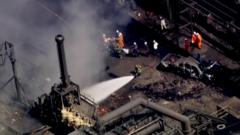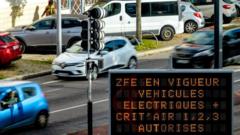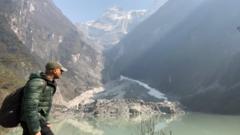Lahore, Pakistan's second-largest city with a population of 13 million, is currently grappling with an unparalleled air quality crisis as toxic smog envelops the region. The Air Quality Index in Lahore reached critical levels, marking the worst air quality ever recorded in the city. In response to this environmental emergency, officials in Punjab province have issued strict measures including the indefinite closure of primary schools and a significant portion of secondary schools until November 17.
Local residents have voiced their distress, sharing the challenges of the thick haze that has infiltrated homes and worsened respiratory hardships. “It’s exhausting to breathe,” lamented Safdar Masih, a 42-year-old gardener, who described the smog as pervasive, managing to enter sealed homes. The authorities’ recent directives also recommend that residents wear masks when venturing outdoors and have instructed around half of the workforce to remain at home.
In an urgent response to the crisis, officials have initiated actions to address pollution sources such as banning rickshaws, closing barbecue establishments, and confiscating vehicles that contribute to the environmental degradation. “We are facing a critical situation,” announced senior Punjab minister Marriyum Aurangzeb, indicating that the harmful air quality conditions might persist for up to ten days.
The public health measures affect over 70 million residents across Punjab, underscoring the widespread impact of Lahore’s air quality disaster. As the city grapples with this pressing issue, the health and safety of its inhabitants hang in the balance, calling for urgent action and long-term solutions to combat air pollution.
Local residents have voiced their distress, sharing the challenges of the thick haze that has infiltrated homes and worsened respiratory hardships. “It’s exhausting to breathe,” lamented Safdar Masih, a 42-year-old gardener, who described the smog as pervasive, managing to enter sealed homes. The authorities’ recent directives also recommend that residents wear masks when venturing outdoors and have instructed around half of the workforce to remain at home.
In an urgent response to the crisis, officials have initiated actions to address pollution sources such as banning rickshaws, closing barbecue establishments, and confiscating vehicles that contribute to the environmental degradation. “We are facing a critical situation,” announced senior Punjab minister Marriyum Aurangzeb, indicating that the harmful air quality conditions might persist for up to ten days.
The public health measures affect over 70 million residents across Punjab, underscoring the widespread impact of Lahore’s air quality disaster. As the city grapples with this pressing issue, the health and safety of its inhabitants hang in the balance, calling for urgent action and long-term solutions to combat air pollution.






















